12 Pantry Essentials For Korean Cooking, According To The CrunchBros
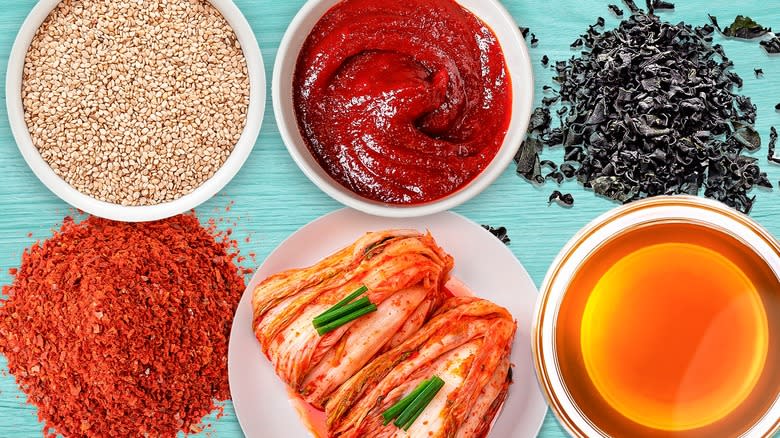
We may receive a commission on purchases made from links.
If you're diving into Korean cuisine, there are a few ingredients that you're going to want to have on hand in your kitchen when you start cooking. You will need to invest in produce and seasonings that you may have never had in your pantry before but are absolutely critical when it comes to creating the nuanced flavors of this cuisine.
For those who have never tried their hand at Korean cooking, the famous father and son YouTube food duo known as the CrunchBros, or Jeff and Jordan Kim, are here to help. They just released a cookbook, "Cooking With the CrunchBros," that has a slew of easy-to-follow and relatively simple, yet delicious, Korean recipes that will appeal to palates of all ages. As Jeff says, home cooks shouldn't be intimidated by trying something new. "You don't have to overcomplicate it and you can really cater to your taste," he explained. "For the most part in our cookbook, everything is really easy."
Since this cookbook is meant for families to cook together and for junior cooks to get in on the action, anyone from the most experienced to the most amateur cook can create a ton of amazing Korean recipes. We sat down to talk with Jeff and Jordan about the Korean pantry essentials they always have at home, and how they manage to weave these ingredients into their unique recipes.
Read more: 21 Delicious Ways To Use Up Leftover Rice
Gochujang
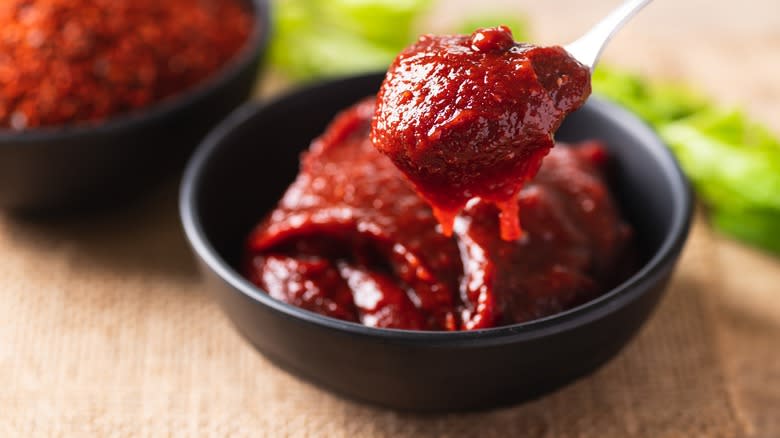
There are few more versatile ingredients than the ubiquitous, reddish gochujang. A mainstay of Korean cuisine, gochujang is most beloved for its adaptability. "It's sweet, it's spicy, a little salty, and you can use it for pretty much anything," Jeff Kim explains. "Straight on your Korean BBQ, in soups, into marinades, you can incorporate it into salad dressings, anything you really want to make spicy, you can use that."
As for what gochujang specifically is? Well, to put it succinctly per Jeff, it's "a flavoring agent made from fermented chili." This ingredient has a sticky, tomato paste-like consistency, which can of course change depending on what it's mixed with or diluted in. Because of gochujang's spice and flavor level, people generally err on the side of using a little of it, rather than a lot, in order to avoid overpowering whatever dish they're making.
In the CrunchBros cookbook, you can find gochujang in a variety of recipes. There are also specific instructions for a sweet and spicy gochujang dipping sauce that many Koreans use with sushi instead of traditional sushi dips.
Gochugaru (Korean Chili Flakes)
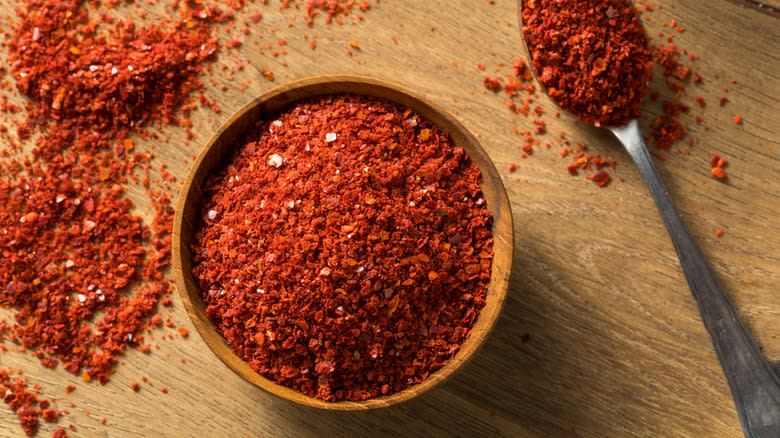
This ingredient is a unique one because not only is it a pantry essential for Korean cooking, but it's also used to make a whole lot of other ingredients that are pantry essentials as well. Gochugaru is Korean chili flakes made from taeyangcho peppers, which makes the resulting red flakes smoky, a little fruity, and spicy (depending on how many pepper seeds end up mixed into the final product).
Within Korean cuisine, it's used to make kimchi — helping give the dish that reddish hue — and gochujang paste. Though gochugaru is used to make gochujang, that doesn't mean the two cancel each other out in a dish. In fact, you will come across a lot of Korean recipes that specifically call for both gochujang and gochugaru to provide different textures to the dish alongside the spice levels. Cooks also utilize these chili flakes when making dry rubs or seasoning a finished dish.
If you decide to make classic homemade kimchi, make sure to use gochugaru instead of generic red pepper flakes or some other substitute. After brining the vegetables for kimchi, mix the gochugaru with a paste made of flour and water in order to create the reddish sauce kimchi is known for today. After you're done, thoroughly cover your brined vegetables with this sauce.
Sesame Oil
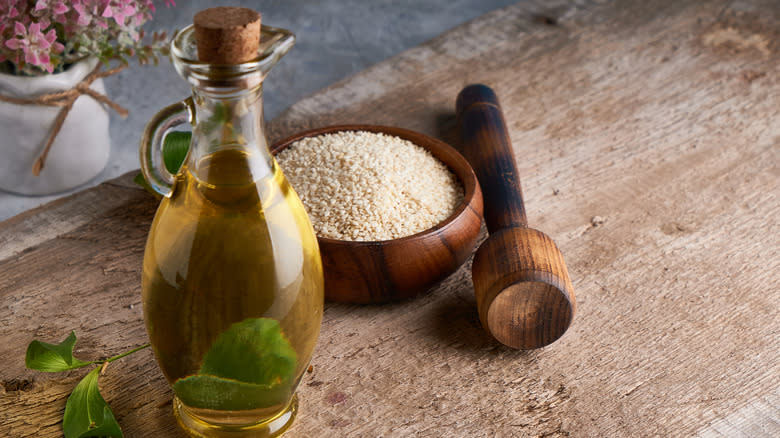
Almost every culture in the world has an oil or butter they absolutely can't live and cook without; in Korea, that's sesame oil. You will find it in every single Korean cook's kitchen, and you will also find yourself constantly reaching for it while making Korean recipes. This oil comes in various shades of brown and helps give an extra dimension of flavor to whatever you're making.
Experts believe that this is one of the most ancient cooking oils that still exists today, as there is evidence that humans were cultivating sesame seeds more than 5,000 years ago in India. Today, those seeds continue to be roasted, ground, and pressed in order to produce the flavorful oil.
But what does sesame oil taste like? Actually, it slightly depends on what type you buy. Not all sesame oils are created equal. Since it's such a quintessential part of Korean cuisine and will have a significant effect on how most of your dishes taste, Jeff Kim believes this is one item you should feel comfortable splurging on a little. "You want to research and choose one that you like, a toasted one, a smoky one, a light one," he says. "That would be one ingredient where you splurge and get something nicer."
Sesame Seeds
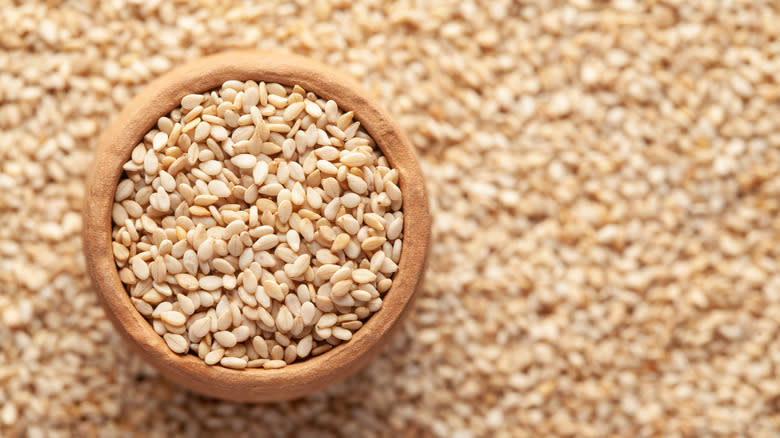
Many Korean cooks use sesame seeds to season and garnish their final dish. Not only does the addition of this ingredient add a mild nutty flavor to the dish, but it also adds a fair amount of texture to meals that might otherwise be too soft or mushy. As a pantry essential, it's commendable for its shelf life, as it can last up to two years unopened. Even opened sesame seeds have a good six months of usability before needing to be tossed.
Sesame seeds are found in a lot of cuisines, perhaps because the sesame plant is extremely resistant to drought and can grow where a lot of other plants don't survive — namely hot, dry conditions. The seeds are usually dried after harvesting and served raw, though some cooks choose to toast them for a minute or two to accentuate the nutty flavor of the seed. In Jeff and Jordan's cookbook, sesame seeds are used on a variety of dishes, including as a sprinkle on their spicy tofu recipe, to add some more flavor and texture, and in the sesame zucchini side dish.
Yuksu/dashi (Dried Anchovy Stock)
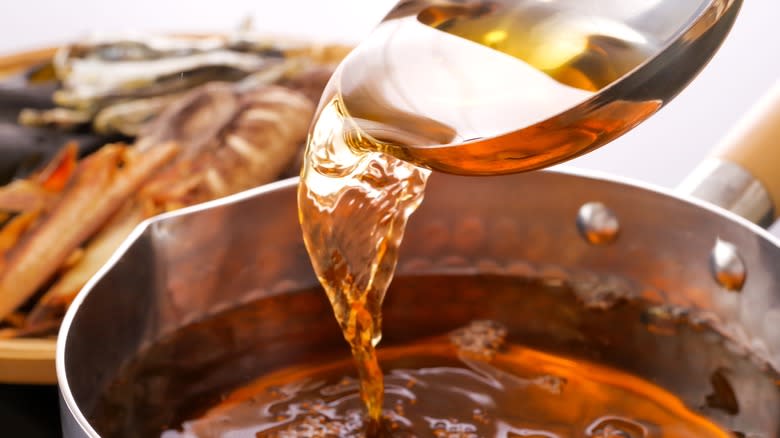
You can't foray into the world of Korean cooking without learning how to make tteokbokki, both because of its delicious taste and how little time it takes to make this particular dish (most chefs can put it together in as little as 15-20 minutes). Though some people leave the dried anchovy stock out of the tteokbokki recipe, most experienced chefs will tell you that the presence of the stock plays a huge part in amplifying the dish's flavor.
When we asked Jeff Kim about the best Korean meals to make with limited time, this rice cake dish shot to the top of the list. And luckily, since not everyone can handle spice, there are options for your tteokbokki. "There's a sweet version, which is non-spicy, and then there's a spicy version too," Jeff told us.
The reason there are two different words for this stock is that in Korean cooking, it's generally called yuksu, but in Japanese cuisine it's known as dashi. Most people around the world know dried anchovy stock by its Japanese name, to the point where some Korean people will also refer to it as dashi. If you want this pantry essential to have an extra long shelf life, consider buying it in powder form.
Soy Sauce
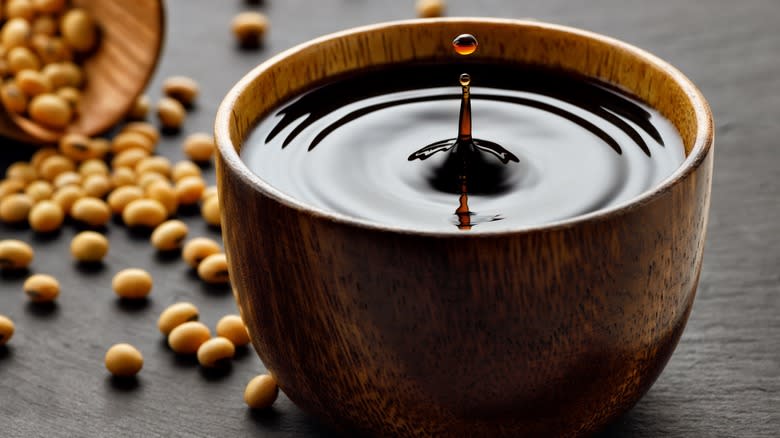
This Japanese mainstay is also a staple of Korean cooking, and should absolutely be a pantry essential if you plan on experimenting with dishes from either culture. The great thing about soy sauce is that it can last almost indefinitely before it is opened, meaning you can keep some in your pantry for months before using it and it won't affect the quality.
After you've opened a bottle of soy sauce, you shoulder transfer it to your refrigerator. However, it will still last a couple of years on your fridge shelf, though it probably won't have its best flavor after six months or so. And when it comes to its use in Korean cuisine, the possibilities are endless. If there are dishes for which you want to take the spice level down or make a non-spicy version, soy sauce will usually be included in the recipe somewhere. For example, the non-spicy version of tteokbokki mentioned above, known as gungjung tteokbokki, uses soy sauce instead of gochugaru and gochujang.
In the CrunchBros cookbook, soy sauce is also used in unconventional, yet simple and tasty recipes that the whole family will enjoy — for example, in the marinated soy sauce eggs. "Once you start eating these, you're never going to go back to regular hard-boiled eggs" the CrunchBros insist. "This recipe will get you hooked."
Beef Stock
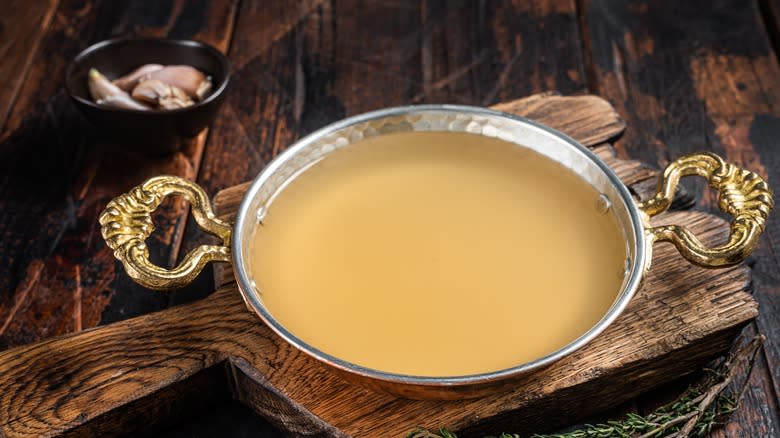
This is yet another ingredient that appears in multiple cuisines around the world, but in Korean cooking, cooks put their own spin on it. To make a traditional Korean beef stock, toss lean beef (preferably shank) into a stockpot along with scallions, onion, black peppercorns, and garlic, and allow it to gently simmer for a while. The rich flavor of the meat will mix with the slight spice of the peppercorns to create a deeply delicious broth that you can then use to flavor other dishes.
If you don't want to make this broth at home and keep it in your fridge for future meal prep, you can also buy ready-made Korean beef broth. The other advantage store-bought beef broth has is that it will last for a much longer time in your pantry — sometimes over a year — if you don't happen to open it and use it for anything. When made at home, though, you can only really safely keep it in the fridge for up to a week or so.
Korean chefs use this beef broth as a base for soups and stews, like this Korean beef stew, as well as an occasional sauce component. You can also add it to rice and noodle dishes in order to enhance the natural taste of the meal.
Dried Seaweed
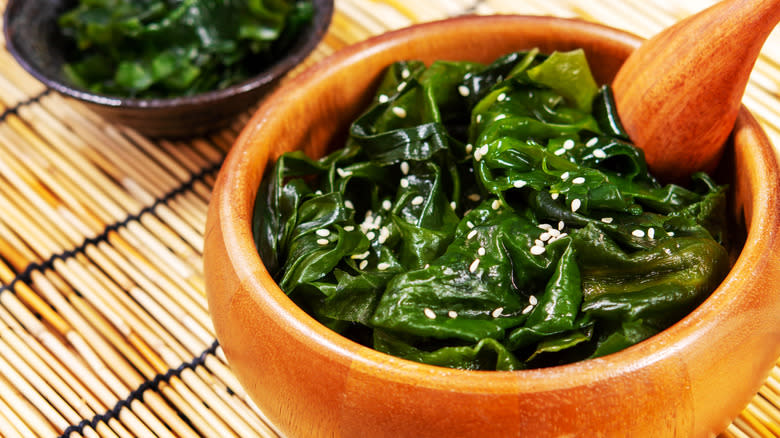
Many East Asian cuisines share an affinity for dried seaweed, though the kind of seaweed used, including its thickness and flavor, can vary from place to place. The good news is, no matter what type you use to cook with, you're likely to be getting a lot of healthy vitamin infusions along with your dinner.
Jeff extolls the virtues of dried seaweed, including its nutritional benefits and minerals. In fact, some people don't even use this pantry staple in order to create other dishes — they just eat it as a snack. "There are snacking ones where you get them in these little containers," Jeff explains, "but then dried ones are gonna be like Italian pasta, you can find it broken up or in long pieces."
Since the CrunchBros also frequently dive into Japanese cooking (and include several Japanese recipes in their new book), they told us that they keep a kind of dried seaweed known as wakame on hand, and mostly use it to make miso soup. You may have to take a trip to your nearest Korean or Japanese food market to pick up dried seaweed, as not every supermarket will sell it, but the extra effort is worth it.
Garlic/garlic Powder
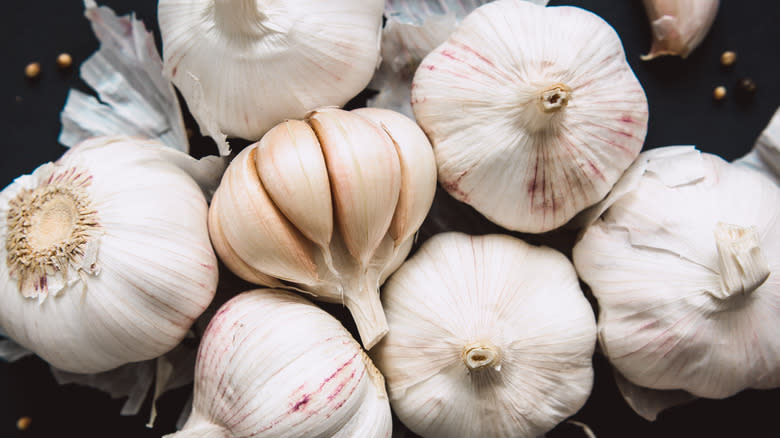
Garlic and garlic powder are both found all over Korean recipes, and the CrunchBros seem to have a particular affinity for it. When asked about his favorite seasoning, Jeff shared, "I would say mine probably has to be garlic powder — there a lot of garlicky foods are in Korean cuisine." Though his son Jordan also likes garlic powder, he made it clear several times that he absolutely loves onion powder — by far his favorite.
In Korea, you will actually find pickled garlic as a side dish in many restaurants. As you might imagine, it doesn't taste like raw garlic, as it goes through an extensive brining process prior to consumption. If you still don't like the idea of eating garlic as a standalone, don't worry, as you will still taste it in plenty of dishes such as jajangmyeon, or Korean black bean noodles. This recipe uses carrots, zucchini, daikon, mirin, and either pork belly or loin, as well as a few cloves of garlic to add that pungent, aromatic taste to the dish and boost the rest of the flavors on the plate.
Kimchi
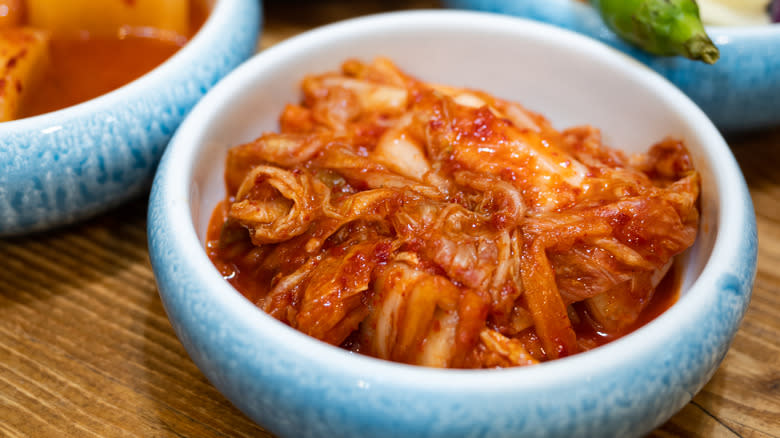
Who has ever gone to a Korean restaurant and hasn't immediately fallen in love with kimchi? This mix of reddish fermented cabbage leaves was first created when Korean residents realized they needed to find a way to preserve fresh vegetables in the cold Korean winters, when few were available.
Though kimchi in this sense refers to the original fermented ingredient, you can actually use kimchi to refer to a whole host of side dishes and variations on the original dish. Jeff and Jordan Kim have found several uses for kimchi in their cookbook, ranging from healthy, traditional Korean recipes, to fusion and kid-friendly food that's fun for the whole family to make and eat.
Jordan particularly likes cucumber kimchi as a dish. In fact, he has already made up his own cucumber kimchi recipe at his young age. This dish requires cucumber, kimchi, mayo, and sesame seeds, among other ingredients you can check out in the cookbook. "That's the healthiest recipe I've ever made in my life", Jordan told us.
If you're looking to whip together a dish and don't have much time on your hands, try the kimchi mac salad instead. Jeff Kim swears by it when he's in a hurry, stating, "our kimchi mac salad is pretty simple. It's a pretty good appetizer, made easily in less than 15 minutes if you're in a rush."
Salt And Pepper

These two classics never go out of style when it comes to almost any cuisine, so of course they would be a significant part of Korean cooking as well. In addition to uniquely Korean condiments, salt and pepper help add some more flavor and nuance to your food.
Though people often lump salt and pepper together, they actually have very different effects on your ingredients, and understanding those differences is important. Salt is a seasoning that highlights and boosts the flavor of your food, while pepper is considered a spice, and thus adds a whole new taste to your meal. Though you don't want to overpower the unique flavors of each dish in Korean cuisine with too much salt and pepper, you will find that both of them are still called for in most recipes. In the CrunchBros cookbook, for example, you will find generous calls for salt and pepper in recipes such as corn cheese, a classic Korean BBQ side dish.
Shiitake Mushrooms (Fresh And Dried)
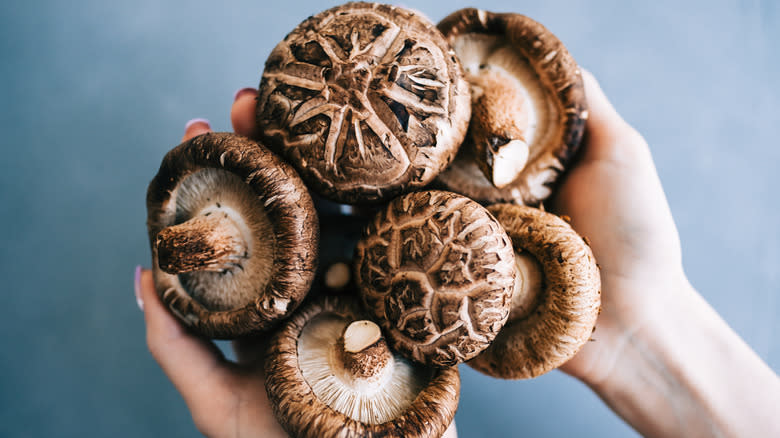
Though fresh shiitake mushrooms belong in the refrigerator, and usually go bad after a week or so, you can keep dried shiitake mushrooms stored in your pantry for a long, long time, as they are a very shelf-stable ingredient. Plenty of Korean recipes call for shiitake mushrooms, but even if they don't, this particular vegetable makes a great replacement for most meats, for those who can't have any. In fact, Korean cuisine in general is uniquely well-suited to vegetarian or pescatarian dietary preferences.
Jeff points out that in Korean cooking, meat is just an option. "There are a lot of recipes where you can just omit the meat," he explains. "You can even just throw in more mushrooms, which will be a little bit more hearty". So if vegetarians and vegans don't want to go the substitute meat route and use something like Impossible Beef, which is still perfectly acceptable in Korean dishes, double up on mushrooms instead. Another recipe that may or may not use meat, depending on your preferences, and employs shiitake mushrooms is japchae, a Korean stir-fry noodle dish.
Read the original article on Tasting Table.

